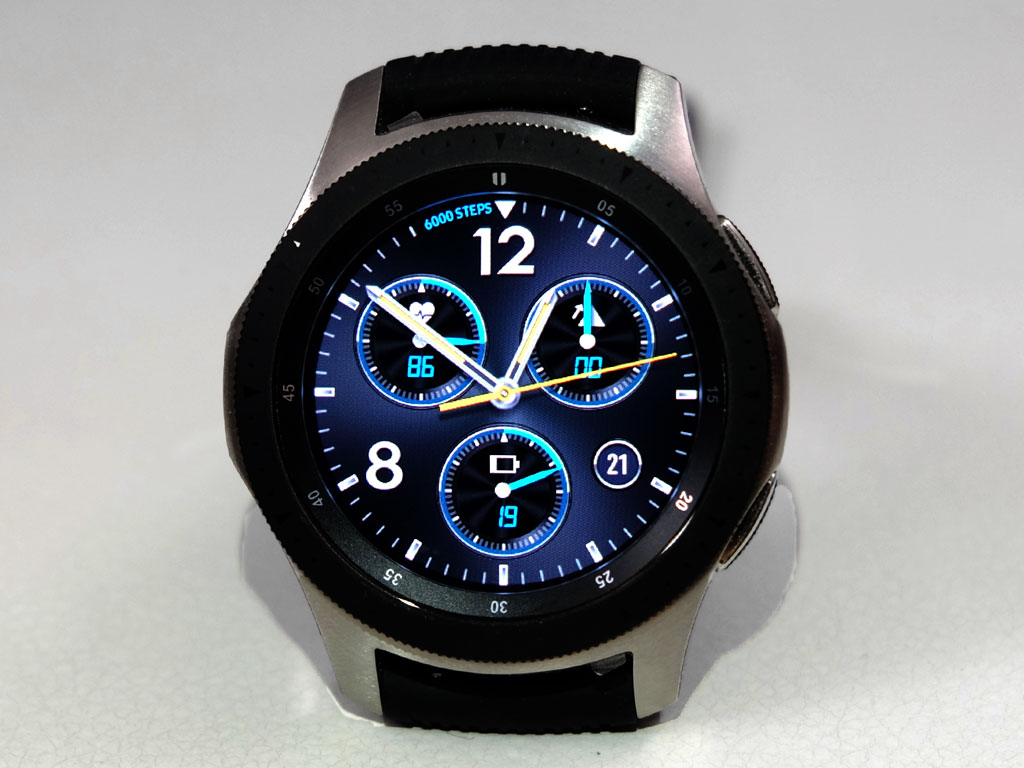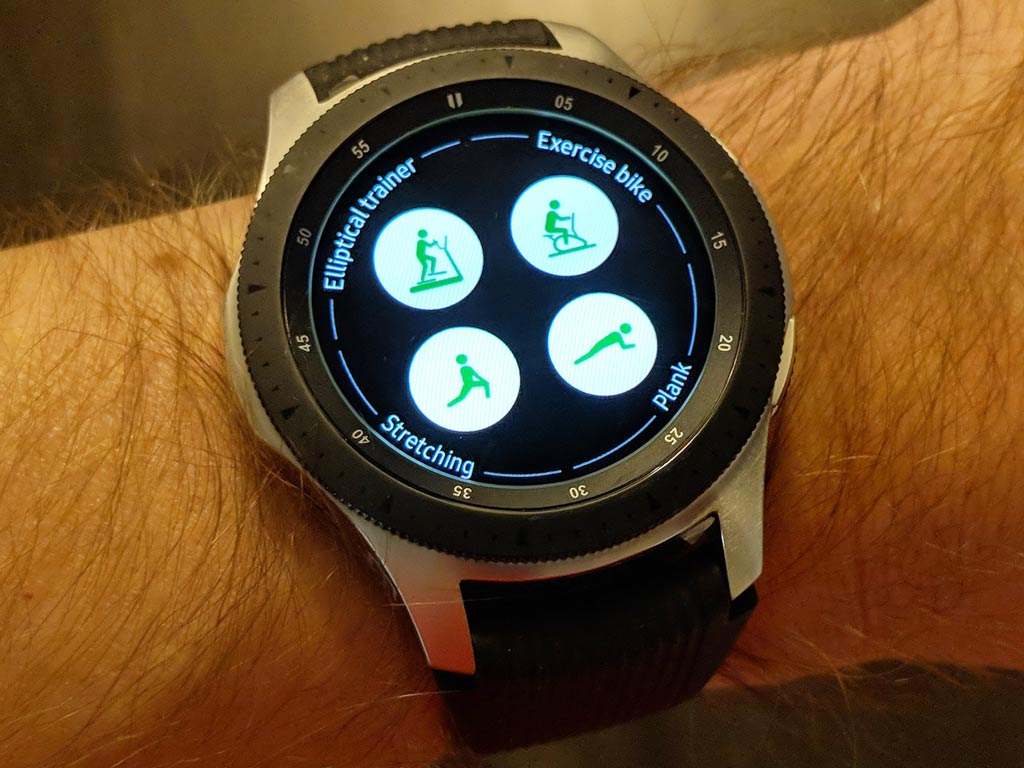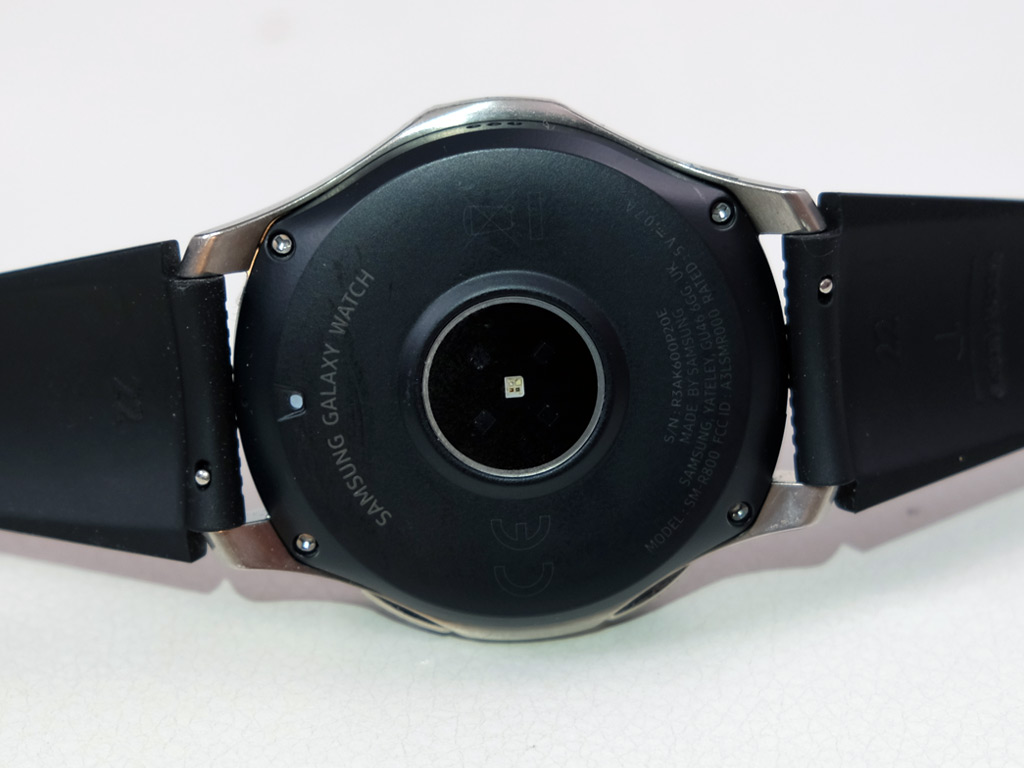
Samsung’s Galaxy Watch is a smartwatch built with some rigidity and a host of features catering to both active and lifestyle users.
To be fair, the Galaxy Watch doesn’t come off as a more refined take on Samsung’s Gear S3 Frontier. It’s more closely linked to the look and feel of the Gear S3 Classic, despite obvious differences. Rather than try reinventing its smartwatch (again), the company sought to improve upon what was done before. To say this is an iterative improvement is true, but there’s more to it all once you experience the full breadth of its performance.
Design and setup
Maybe it’s just me, but I get the sense that Samsung is trying to create a body that looks like a nice timepiece, while also staying true to the uniqueness of a smartwatch. As before, the Galaxy Watch comes in two sizes—46mm and 42mm.
The 42mm size is the same as the Gear Sport, another Samsung smartwatch that was chiefly focused on fitness and active needs. The rose gold version of this watch only comes in 42mm, ostensibly to appeal to a wider demographic—namely women. The silver and black models come in both sizes, though the 46mm will likely appeal to men only.
Neither size comes with any demonstrable difference in performance. The same features apply. It just comes down to styling. For bigger wrists, this combination will feel right, but I would personally go with the 42mm because mine is thinner.
A similar steel frame hugs the watch face and rotating bezel that is the central piece of the functionality. My review unit came with a fairly thick silicone band that retains the same plain design of previous models. They use standard lugs, so replacing the band with almost anything from another watch is really easy.
The 1.3-inch touch display for the 46mm (it’s 1.2-inches for the 42mm) is an OLED panel that is every bit as vibrant as before. It’s also pretty bright, rarely giving me a problem seeing it in direct sunlight. An optical heart rate sensor sits underneath
Like the Gear Sport, this watch has a 5ATM rating, which means it’s waterproof down to 50 metres. That includes saltwater, so a dip in the ocean is no problem. Still, I always advise rinsing after swimming in oceans, lakes or pools to clear out any salt, sand or chlorine.
You can use Bluetooth and Wi-Fi to connect with the paired phone. There’s about 2.5GB of internal storage that’s actually free to use for storing apps and music. You can load up music files and play them directly from the watch to Bluetooth headphones, if you want.
Samsung also made the watch compatible with Samsung phones and Android phones running version 5.0 or later. The list also includes the iPhone, from the 6s and 6s Plus onward.

Software
The two buttons on the side do the same things. One is a back button, the other a home button to go back to the main screen. The rotating bezel navigate menus within the interface, which is based on Tizen, Samsung’s own operating system.
In dropping the “Gear” designation for this watch, Samsung did the same for the app. What used to be the Samsung Gear app is now Galaxy Wearable. It’s still free to download from Google Play. Pairing the watch was super easy, with my Galaxy S9 recognizing it right away without even launching the app.
Setting up the watch isn’t especially challenging, either, thanks to the step-by-step guide upon startup. As per usual, you can customize some of the watch’s look. Choose from a myriad of watch faces and download apps directly from the Galaxy Store without going through the phone first.
Indeed, the number of watch faces to choose from borders on ridiculous. Never mind the ones you can select directly from the watch, there are collections you can get from Galaxy Apps on your phone, too.
One of the key app additions I picked up on was Spotify. I had wanted to see this on a Samsung smartwatch for some time, and thankfully, the integration is quite good. I was able to navigate the interface and control playback without pulling out the phone. Unfortunately, there was no way to do the same with other streaming apps. Google Play Music, Apple Music, Tidal, SoundCloud and others are far more limited. I could only play/pause or skip/repeat tracks in those cases.
The overall app selection is showing slow signs of improvement, albeit ominous ones as well. Uber is available, but at the time I used it, it was buggy, sometimes freezing. Since the season hasn’t started yet, I wasn’t able to gauge how good the NBA app is, but it’s supposed to make it easy to keep up on scores and stats. Notably missing is anything for the NHL and NFL.
Third-party developers step in to try and close the gaps. For example, people have made apps to work with Google Maps, Philips Hue lights, Nest Thermostats, and a variety of other products or services. Some cost money, others don’t. Either way, they are sometimes the only options available.

Performance
I’ve previously described Samsung’s smartwatches as activity trackers in watch forms. I don’t know that the Galaxy Watch is any different. Samsung pushes its Health app as a dynamic aid for health and fitness, and tried to add some dynamism to the mix.
The watch tracks steps, stairs, calories burned and distance travelled (through the built-in GPS). It used to be able to only track workouts manually, but now, it can also identify some automatically. There are 39 total, with six — walking, running, cycling, elliptical, training and dynamic workouts — tracked without manual input. The first four are pretty obvious, but the last two are going to be less precise because the parameters are so wide. Still, it’s nice that common ones like walking, running, biking and elliptical are consistently tracked. With the heart rate sensor and stress test, something of a holistic picture comes out.
In trying to make the Galaxy Watch multifaceted, Samsung presents different ways to make the watch feel active. Swiping right from the home screen brings up shortcuts to the apps you want to use most. There are shortcut widgets to a lot, like weather, contacts, reminders, calendar entries, sleep tracking, among many others. You can add more, which can be a convenient way to skip going through the app menu.
Notifications are treated in much the same way. Getting incoming messages or email, I could respond without using the phone. Within reason, of course. Longer responses were always better on the phone. But it was also based on app availability. U.S. users get more apps than we do in Canada, so those limitations cast a wider shadow here.
However, I was able to use voice to do some of these things. Bixby’s inclusion is going to be divisive, not least of which because Google Assistant is already very good. By saying, “Hi Bixby,” I was able to issue commands directly to the watch. Simple things, like “play music” or “show me the weather” worked fine. I could also dictate text messages to contacts.
Still, Bixby’s shortcomings are evident early on. I couldn’t tell it which app to play music from, nor did it recognize an artist, like Google Assistant does. The microphone and speaker on the watch are decent, except I noted a number of instances where it misinterpreted what I said.
With the iPhone
It’s nice to see that Samsung supports the iPhone with the Galaxy Watch, just don’t expect everything. For example, notifications will get through, but are otherwise not actionable on the watch. Same with accepting an incoming call. You have to pull your phone out.
Galaxy Apps are also out of reach, unless you download plug-ins and other software to bridge the gap. I found it tedious and unintuitive, and would not recommend the Galaxy Watch for iPhone users. You would get better setup and integration with an Apple or Wear OS watch.

Battery
The 46mm model has a 472mAh battery, whereas the 42mm has a 270mAh one. It’s a sizeable difference, which is why the larger one could probably last an extra day before needing to charge. I didn’t get to test the smaller model, but I suspect I’m correct based on how this one did.
I kept the always-on screen off and used the watch moderately over the course of a few days, hitting three days without a problem. If I turned off Wi-Fi and GPS, I hit four days. If I turned all those things on, and ramped up usage, I couldn’t go beyond two days.
Final Thoughts
There are still holes to fill, but this is Samsung’s best attempt at making a good smartwatch. The aesthetics are pretty good, and the overall user experience is improving. I’d like to see more apps people want to be available, though there is decent customization already. Spotify’s addition is big, as is the breadth and depth of the health and fitness content on the Galaxy Watch.
I’m not crazy about Bixby, but at least it can do certain tasks well. Even Samsung Pay will work if you are with a participating bank. The collection of features and performance make the Galaxy Watch compelling because the platform it runs on has matured. Tizen doesn’t feel like a work in progress at every step.
The Samsung Galaxy Watch is available now.



